In various industries, lone workers face unique challenges and risks. From field researchers to construction site inspectors, ensuring their safety is crucial. Advancements in personal safety alarms have revolutionized the way lone worker protection is approached, offering more reliable and effective solutions. This guide explores these advancements and how they contribute to the safety of individuals working alone.
Understanding Lone Worker Risks and Safety Solutions
Lone workers are those who perform an activity isolated from others without close or direct supervision. Such workers are particularly vulnerable in emergency situations. Modern solutions, like man-down duress alarms, have been developed to provide immediate alerts when a worker is incapacitated or in danger. These alarms are a significant step forward in enhancing lone worker safety.
Types of Personal Safety Alarms for Lone Workers
Personal safety alarms for lone workers come in various forms, each designed to address specific risks:
- Man-Down Alarms: These devices detect sudden falls or lack of movement, automatically sending an alert for help.
- Panic Buttons: Worn by the worker, these buttons can be pressed in an emergency to send an immediate distress signal.
- GPS-Enabled Devices: Provide real-time location tracking, crucial for workers in remote areas.
- Check-In Systems: Require workers to periodically check in via an app or device, ensuring regular communication.
Advancements in Technology Enhancing Safety
Technological advancements have significantly improved lone worker safety:
- Smartphone Integration: Many safety devices now integrate with smartphones, providing easy access and control.
- Improved Communication: Enhanced connectivity options such as Wi-Fi, Bluetooth, and cellular networks allow for better and more reliable communication.
- Wearable Technology: Compact and wearable devices ensure that safety tools are always on-hand without being intrusive.
- Automated Monitoring: Automated systems continuously monitor the worker’s status and send alerts without the need for manual activation.
The Role of Software in Lone Worker Protection
Software platforms play a vital role in managing lone worker safety. These systems can:
- Monitor Alerts: Keep track of any distress signals sent by the safety devices.
- Coordinate Response: Ensure quick and organized emergency responses.
- Maintain Records: Keep detailed records of incidents for compliance and improvement of safety protocols.
Best Practices in Implementing Lone Worker Safety Alarms
Implementing lone worker safety alarms effectively requires a strategic approach:
- Assess the Risks: Understand the specific risks associated with the lone worker’s role and environment.
- Choose Appropriate Devices: Select devices that best suit the worker’s needs and the nature of their work.
- Provide Training: Ensure workers are trained on how to use the devices and understand the protocols.
- Regular Testing and Maintenance: Regularly test the devices and keep them well-maintained to ensure reliability.
Challenges and Considerations
While advances in personal safety alarms have enhanced protection, there are challenges:
- Ensuring Compliance: Workers need to consistently use and carry the devices.
- Privacy Concerns: Balancing safety with the worker’s privacy, especially regarding GPS tracking.
- Costs and Resources: Implementing and maintaining these systems can be costly and resource-intensive.
The Future of Lone Worker Safety Alarms
The future of lone worker safety looks promising with ongoing technological developments:
- AI and Machine Learning: These technologies could provide predictive insights to prevent accidents.
- Improved Wearable Technology: Further miniaturization and enhanced features in wearable devices.
- Integration with Other Systems: Integration with health monitoring systems for comprehensive well-being checks.
A Commitment to Lone Worker Safety
Advances in personal safety alarms represent a significant commitment to the safety and wellbeing of lone workers. As technology continues to evolve, it offers new and better ways to ensure that workers in isolated environments are protected and supported. It’s crucial for industries relying on lone workers to stay abreast of these advancements and integrate them into their safety protocols. The goal is not just compliance but a genuine safeguarding of the workforce’s health and safety.
ⓘ LAFFAZ is not responsible for the content of external sites. Users are required to read and abide by our Terms & Conditions.








